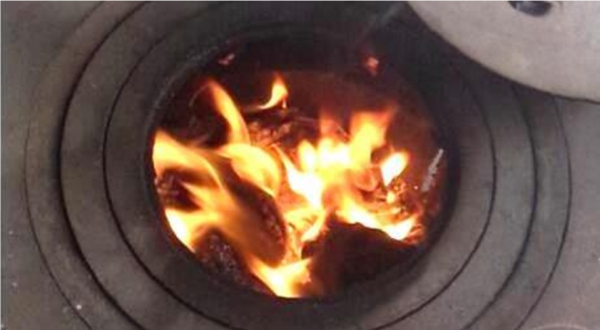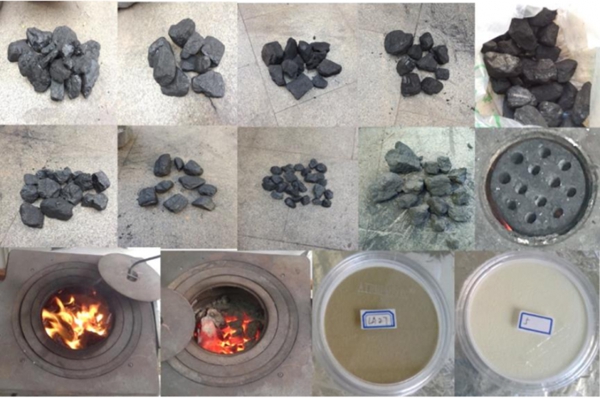
Photograph of coal combustion in a residential stove
Coal, one of the most important energy resources, is widely used around the world in power generation, industrial production, household cooking, heating, and so on. In China, 91 Tg coal was used in the residential sector for cooking and heating in 2016. Due to the lack of particle treatment apparatus, residential coal combustion releases large amounts of carbonaceous particles into the atmosphere, such as organic carbons and black carbons (Zhang et al., 2007).
Nitrated phenols, organic molecules that consist of at least one hydroxyl radical and one nitro functional group connected to an aromatic ring, are one of the major components of brown carbon. Nitrated phenols can strongly absorb UV and visible light and thus affect the radiation balance and further regional climates (Mohr et al., 2013). Besides, nitrated phenols do harm to humans and organisms (Fernandez et al., 1992; Harrison et al., 2005). Nitrated phenols in the atmosphere come from both the primary emissions of combustion processes and the secondary formation from aromatic precursors. Biomass burning has been recognized as the major emission source of nitrated phenols (Hoffmann et al., 2007), however, it remains unclear whether there are direct emissions from the combustion of various kinds of coals.
Considering the huge consumption of coal for residential use and the lack of dust removal devices, Dr. Xingfeng Wang and his Ph.D. student Chunying Lu and collaborators from Shandong University conducted laboratory experiments to investigate the emissions of ten nitrated phenols in fine particulate matters from combustions of ten kinds of coals including chunks of lignite, bituminite, and anthracite, as well as anthracite briquettes. As an important complement to the traditional view of major emission source of biomass burning, they found that coal combustion directly emitted a large amount of nitrated phenols and acted as another major emission source of these brown carbons.

Photographs of selected coals, the deployed stove with coal combustion, and the collected fine particulate matters on quartz filters.
This laboratory study shows that the emission profiles of fine particulate nitrated phenols from coal combustion were similar to those from biomass burning. The emission factors of nitrated phenols for various coals were 0.2–10.1 mg kg-1. Compared to the emissions factors from biomass burning, the emission factors of nitrated phenols from coal combustion for lignites and bitu
minites were comparable or even a little higher. The estimated total amount of fine particulate nitrated phenols directly emitted from residential coal combustion in China in 2016 was 178±42 Mg, approximately a quarter of that from biomass burning in China (Wang et al., 2017). The emission of nitrated phenols from coal combustions in all sectors including residential use, thermal power plants, and industrial productions would be more.
This work confirms the direct emission of nitrated phenols from coal combustion. The findings indicate the notable contribution of coal combustion to the nitrated phenols in atmosphere particularly in winter when a huge amount of coal is burnt for heating, which has been observed in their recent field studies at four sites in North China (Wang et al., 2018).
Interestingly, the emission factors of nitrated phenols from coal combustion varied with coal kinds, decreasing dramatically with coal maturity. Why would coal combustion produce nitrated phenols and did the emission factors decreased with coal maturity? It was clarified that coal originated from biomass and consists mainly of highly condensed aromatic compounds with various functional groups. When coal was burning, nitrated phenols were likely generated from the reactions among the pyrolysis products which contain phenolic structures and nitrogen oxides. The content of phenolic carbon decreased as coal rank increased, and thus lignite emitted more nitrated phenols than bituminous coal and anthracite.
This work provides a comprehensive understanding of the emissions of nitrated phenols from residential coal combustion and provides important basic data for the emission inventory and atmospheric modeling. It puts forward the urgent need to enforce emission control measures and to promote clean coal utilization in the residential sector in China. In order to decrease the emissions of nitrated phenols from residential coal combustion, the public can reduce coal use by replacing coal with clean energy such as natural gas, solar energy, and wind energy.
These findings are reported in the article entitledEmissions of fine particulate nitrated phenols from residential coal combustion in China, recently published in the journal Atmospheric Environment (Atmospheric Environment 203(2019)10-17). This work was conducted by the group of Dr. Xinfeng Wang and collaborators from Shandong University, including Chunying Lu (first author), Xinfeng Wang (corresponding author), Rui Li, Rongrong Gu, Yinxiao Zhang, Bing Chen, Weijun Li, Likun Xue, Wenxing Wang, and Rui Gao.
Source: Science Trends
Edited by: Shi Yajie, Xie Tingting